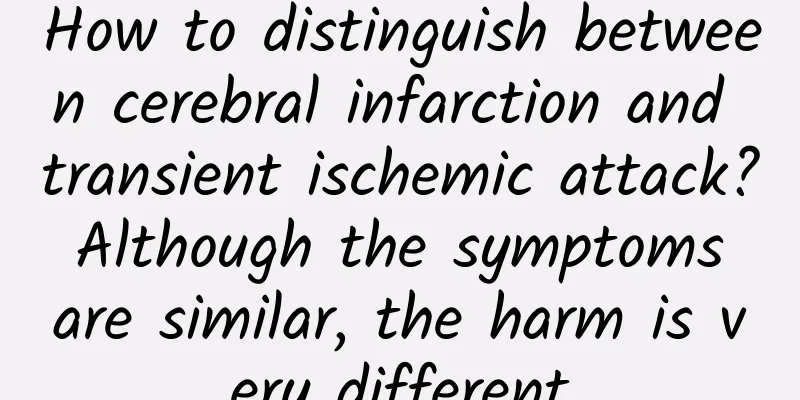How to distinguish between cerebral infarction and transient ischemic attack? Although the symptoms are similar, the harm is very different

|
TIA, or transient ischemia, is a very common symptom in patients with cardiovascular and cerebrovascular diseases. Its symptoms are easily confused with cerebral infarction. Both have symptoms such as dizziness, weakness on one side of the limbs, paralysis of one side of the face, limited language function, and memory loss. During imaging examinations, abnormalities of cerebral infarction can be seen through CT or MRI, but TIA does not cause any changes to the brain, so there are no obvious abnormalities in CT and MRI. In terms of impact, TIA is a temporary interruption of blood supply to a certain area of the brain. It does not last long and will not cause permanent damage to the brain. Therefore, the patient's discomfort symptoms are often transient, appearing and disappearing suddenly, and the patient feels better after a rest. It generally does not cause much impact on the patient. Cerebral infarction is an interruption of blood supply to a certain area of the brain, which lasts for a long time and causes permanent damage to the brain, thereby affecting the patient's limbs and other body functions. The symptoms are permanent and can be relieved to a certain extent through rehabilitation training, but they cannot be cured, and may endanger the patient's life as the disease progresses, with high disability and mortality rates. But no matter what the symptoms and effects are, the causes of cerebral infarction and TIA are the same. Heart disease, moyamoya disease, carotid artery stenosis, cardiovascular and cerebrovascular abnormalities, etc. can cause patients to experience these two symptoms. Some patients do not have a deep understanding of TIA and think they are very lucky not to develop cerebral infarction. However, if TIA is not taken seriously, it may lead to the development of the disease and the patient may suddenly suffer a stroke, and the probability of this is very high. |
<<: Which cabinet door panel is good? Is it ugly to add a top cover to the cabinet wall cabinet?
Recommend
What can I eat after giving birth?
Sooner or later a woman will experience childbirt...
Can uterine fibroids be treated in their early stages?
A large proportion of people in society have no k...
Causes of vulva itching at night
I believe everyone must know the importance of th...
Can I test for pregnancy one day after my period?
It is not easy to get pregnant if you have your p...
Qingbitang Science Popularization: Want to solve sinusitis? First of all, you must quit these three bad habits!
It has to be said that in modern society, sinusit...
Precautions after wearing the ring
Family planning is China's birth policy, so w...
What is the reason for the growth of fleshy bumps at the vaginal opening?
In daily life, women must learn to take good care...
Should I use high or low heat for milky white crucian carp soup? What is the heat for the crucian carp soup to be white?
We all know that crucian carp soup is a common no...
Is it possible to get pregnant without mature follicles?
The egg in a woman's body refers to a compone...
What to do if the gas does not pass after caesarean section
Many women will choose cesarean section when givi...
How long after abortion can I take a shower?
It is best to take a bath 7 days after the aborti...
Why do I have diarrhea during my period?
In addition to dysmenorrhea, most women also expe...
What to do if you don’t have your period after 40
If a 40-year-old woman does not have her period, ...
What snacks are good for girls?
I believe there is no girl who doesn’t like snack...
My period has not ended for six days. What's going on?
In our lives, many women feel abdominal pain and ...









